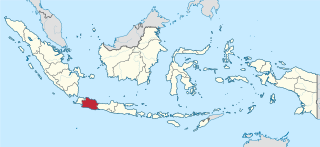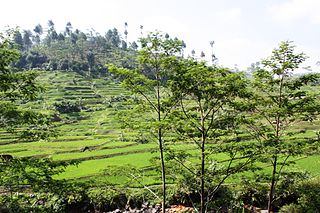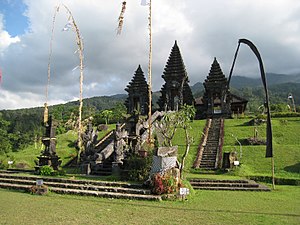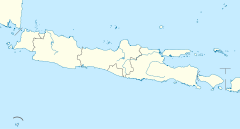
West Java is a province of Indonesia on the western part of the island of Java, with its provincial capital in Bandung. West Java is bordered by the province of Banten and the country's capital region of Jakarta to the west, the Java Sea to the north, the province of Central Java to the east and the Indian Ocean to the south. With Banten, this province is the native homeland of the Sundanese people, the second-largest ethnic group in Indonesia.

Balinese Hinduism is the form of Hinduism practised by the majority of the population of Bali. This is particularly associated with the Balinese people residing on the island, and represents a distinct form of Hindu worship incorporating local animism, ancestor worship or Pitru Paksha, and reverence for Buddhist saints or Bodhisattava.

Bogor is a city in the West Java province, Indonesia. Located around 60 kilometers (37 mi) south of the national capital of Jakarta, Bogor is the 6th largest city in the Jakarta metropolitan area and the 14th overall nationwide. The city covers an area of 118.50 km2, and it had a population of 950,334 in the 2010 Census and 1,043,070 in the 2020 Census. The official estimate for mid 2022 is 1,099,422. Bogor is an important economic, scientific, cultural, and tourist center, as well as a mountain resort.

Hinduism in Indonesia, as of the 2018 census, is practised by about 1.74% of the total population, and almost 87% of the population in Bali. Hinduism is one of the six official religions of Indonesia. Hinduism came to Indonesia in the 1st-century through traders, sailors, scholars and priests. A syncretic fusion of pre-existing Javanese folk religion, culture and Hindu ideas, that from the 6th-century also synthesized Buddhist ideas as well, evolved as the Indonesian version of Hinduism. These ideas continued to develop during the Srivijaya and Majapahit empires. About 1400 CE, these kingdoms were introduced to Islam from coast-based Muslim traders, and thereafter Hinduism mostly vanished from many of the islands of Indonesia.

Sukabumi Regency is a regency (kabupaten) in southwestern Java, as part of West Java province of Indonesia. The regency seat is located in Palabuhan Ratu, a coastal district facing the Indian Ocean. The regency fully encircles the administratively separated city of Sukabumi. Covering an area of 4,145.70 km2, the regency is the largest regency in West Java and the second largest regency on Java after the Banyuwangi Regency in East Java. The regency had a population of 2,341,409 at the 2010 census and 2,725,450 at the 2020 census. with a large part of it living in the northeastern part of the regency that encircles Sukabumi City, south of Mount Gede. A plan to create a new regency, the North Sukabumi Regency is currently waiting for the approval of the central government.

Tasikmalaya Regency is a regency in the province of West Java, Indonesia. It covers an area of 2,708.82 km2, and had a population of 1,687,776 at the 2010 census, which rose to 1,865,203 at the 2020 census. Located in the southeastern region of Priangan (Preanger), the regency is by far the biggest and the most important regency in East Preanger. The regency was previously administered from Tasikmalaya City, which however is now administratively independent of the regency, and the administrative centre of the regency is now at Singaparna to the west of the city.

The Salakanagara Kingdom is the first historically recorded Indianised kingdom in Western Java. The kingdom existed between 130-362 AD.
Claudius Ptolemaeus wrote about Java in his book, Geographie Hypogenesis. He mentions the name of Argyre Chora in Labadio. According to the historian, Labadio means Dwipa-Javaka, Dwipa-Javaka or Java Dwipa, which is the ancient name of Java Island. There was one kingdom which rule west coast Java in 160 AD, Salakanagara. Salakanagara means “Silver Nation”. It reinforces the theory that Ptolemaeus may have visited Java in 160 AD.
A relatively modern literature in the 17th century Pustaka Rajya Rajya i Bhumi Nusantara describes Salakanagara as being founded by an Indian merchant from Pallava Kingdom.

The Sunda Kingdom was a Sundanese Hindu kingdom located in the western portion of the island of Java from 669 to around 1579, covering the area of present-day Banten, Jakarta, West Java, and the western part of Central Java. The capital of the Sunda Kingdom moved several times during its history, shifting between the Galuh (Kawali) area in the east and Pakuan Pajajaran in the west.

The Sultanate of Cirebon was an Islamic sultanate in West Java founded in the 15th century. It is said to have been founded by Sunan Gunungjati, as marked by his letter proclaiming Cirebon's independence from Pajajaran in 1482, although the settlement and the polity had been established earlier, in 1445. Sunan Gunungjati also established the Sultanate of Banten. It was one of the earliest Islamic states established in Java, along with the Sultanate of Demak.

Pakuan Pajajaran was the fortified capital city of Sunda Kingdom. The location is roughly corresponds to modern Bogor city in West Java, Indonesia, approximately around the site of Batu Tulis. The site is revered as the spiritual home of Sundanese people as it contains much of shared identity and history of Sundanese people.
Sri Baduga Maharaja or Sang Ratu Jayadewata was the great king of the Hindu Sunda kingdom in West Java, reigned 1482 to 1521 from his capital in Pakuan Pajajaran. He brought his kingdom greatness and prosperity.

Parahyangan is a cultural and mountainous region in West Java province on the Indonesian island of Java. Covering a little less than one sixth of Java, it is the heartland of Sundanese people and their culture. It is bordered to the West by Banten province, to the North by the northern coast region of Subang, Cirebon and Indramayu, to the east by Central Java province, and to the south by the Indian Ocean.

Hyang is a representation of the Supreme Being, in ancient Java and Bali mythology. This spiritual entity can be either divine or ancestral. The reverence for this spiritual entity can be found in the folk religions of Java and Bali; such as the Sunda Wiwitan, Kejawen, Kapitayan, and Gama Tirta. The realm where Hyang resides is called the Kahyangan, which is an Old Javanese term that literally means "the abode of Hyang", "part of Hyang", or "heaven".

A pura is a Balinese Hindu temple, and the place of worship for adherents of Balinese Hinduism in Indonesia. Puras are built in accordance to rules, style, guidance and rituals found in Balinese architecture. Most puras are found on the island of Bali, where Hinduism is the predominant religion; however many puras exist in other parts of Indonesia where significant numbers of Balinese people reside. Mother Temple of Besakih is the most important, largest and holiest temple in Bali. Many puras have been built in Bali, leading it to be titled "the Island of a Thousand Puras".

The Batutulis inscription is an ancient Sunda Kingdom inscription dated 1533, located at Batutulis village, South Bogor, West Java. Batutulis inscription is located in the ancient site of the capital Pakuan Pajajaran, Batutulis means 'inscribed stone', it is this stone, still in situ, which gave name to the village. The complex of Batutulis measures 17 x 15 metres. Several other inscribed stones from Sunda Kingdom also located in this location. The inscription was written in Old Sundanese language. The Batutulis inscriptions were created in 1533 by king Surawisesa to honor and commemorate his late father, the great king Sri Baduga Maharaja or known as Ratu Haji Pakuan Pajajaran Sri Sang Ratu Dewata. Sri Baduga Maharaja is also known in local tradition as King Siliwangi.

King Siliwangi or Prabu Siliwangi was a semi-legendary great king of the Hindu Sunda kingdom prior to the coming of Islam in West Java.

Pura Penataran Agung Lempuyang is a Balinese Hindu temple or pura located in the slope of Mount Lempuyang in Karangasem, Bali. Pura Penataran Agung Lempuyang is considered as part of a complex of pura surrounding Mount Lempuyang, one of the highly regarded temples of Bali. The temples of Mount Lempuyang, represented by the highest pura at the peak of Mount Lempuyang, Pura Lempuyang Luhur, is one of the Sad Kahyangan Jagad, or the "six sanctuaries of the world", the six holiest places of worship on Bali.
King Niskala Wastu Kancana or also known as Prabu Raja Wastu or popularly known as Wastu Kancana was one of the great kings of the Sunda Kingdom reigning throughout most of the 15th century.

The history of Sunda Kingdom spanned almost a millennium, between 7th to 16th century. It is not sure however, whether the Sunda Kingdom was actually a continuous polity or not, nor whether its rulers belongs to a single continuous lineage of dynasty or not. This is because the scarcity of evidences, historical records and archaeological findings that plausibly connected to this kingdom.



















